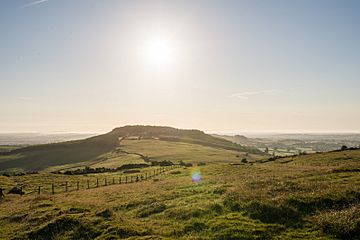Slieve na Calliagh facts for kids
Quick facts for kids Slieve na Calliagh |
|
|---|---|
| Sliabh na Caillí | |
 |
|
| Highest point | |
| Elevation | 276 m (906 ft) |
| Prominence | 171 m (561 ft) |
| Listing | County Top (Meath), Marilyn |
| Naming | |
| English translation | the hag's mountain |
| Language of name | Irish |
| Geography | |
| Location | County Meath, Republic of Ireland |
| Parent range | Meath Hills |
| OSI/OSNI grid | N586775 |
Slieve na Calliagh (Irish: Sliabh na Caillí, meaning the Cailleach's mountain) is a group of hills and an amazing old place near Oldcastle, County Meath, Ireland. It's the highest point in County Meath, standing at 276 meters (about 905 feet) tall. This area is super important because it has many ancient tombs called megalithic tombs.
What's in a Name?
The name "Slieve na Calliagh" comes from the Irish language. It means "the hag's mountain." A "hag" is an old, wise woman, often with magical powers, from Irish stories.
There's a cool legend about how these hills got their name. People say a giant hag was walking across the land, carrying huge stones in her apron. As she walked, some of these big stones fell out, creating the hills and the ancient monuments we see today!
Where is Slieve na Calliagh?
Slieve na Calliagh isn't just one hill. It includes several hills like Carnbane West, Carrickbrack, Carnbane East, and Patrickstown Hill. These hills are part of the Meath Hills range.
Ancient Tombs and History
On top of these hills, you can find very old tombs called megalithic tombs. These tombs were built a very long time ago, around 4,000 BC (that's 6,000 years ago!). They are also known as the Slieve na Calliagh tombs.
These tombs are a special type called passage graves. This means they have a long narrow passage leading to a burial chamber. They were built around 3,000 BCE. Scientists think the people who built these tombs were descendants of early settlers in Ireland. These settlers came from a place called Brittany, which is in modern-day France, around 4,200 BCE.
Many people have studied these amazing sites. An archaeologist named E.A. Conwell first described them in 1864. Later, Rotherham in 1895 and George Coffey in the early 1900s also explored them. The art found in these tombs might even be older than similar art at the famous Brú na Bóinne site in the Boyne Valley.
There are more than 30 known archaeological sites here, but there might have been as many as 50 to 100 mounds in the past! The two main tombs are called Cairn L and Cairn T. Cairn T is also known as the Hag's Cairn.
Inside Cairn T, there's a special carved stone called the Equinox Stone. What's amazing is that the sun shines directly on this stone at sunrise during the Spring equinox. Above it, a decorated ceiling stone also gets lit up by the sun at that exact moment. It shows how clever these ancient builders were!
See also
 In Spanish: Sliabh na Caillí para niños
In Spanish: Sliabh na Caillí para niños



